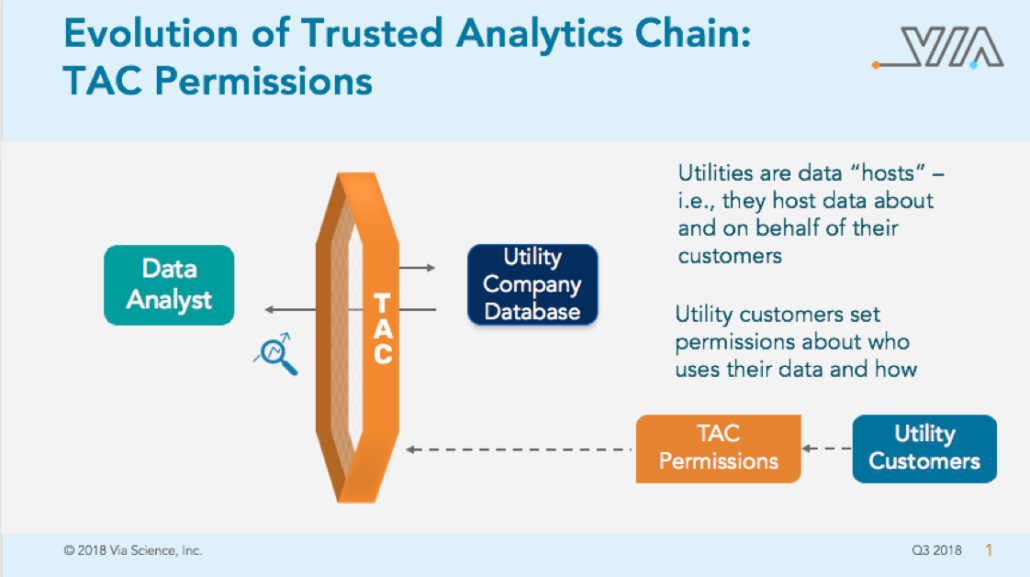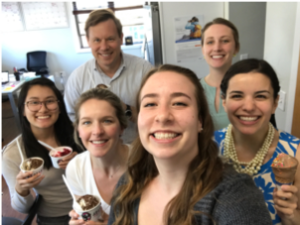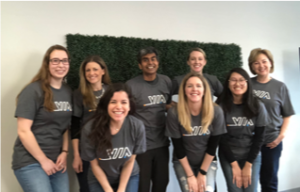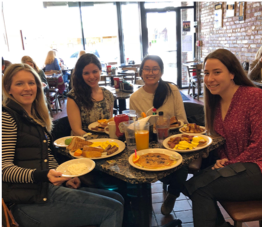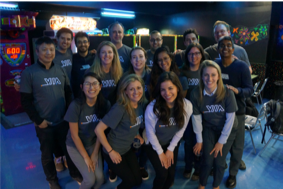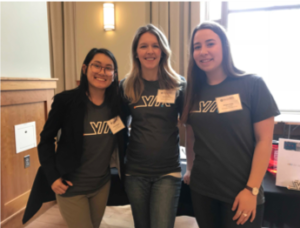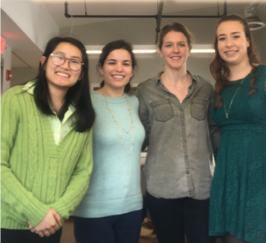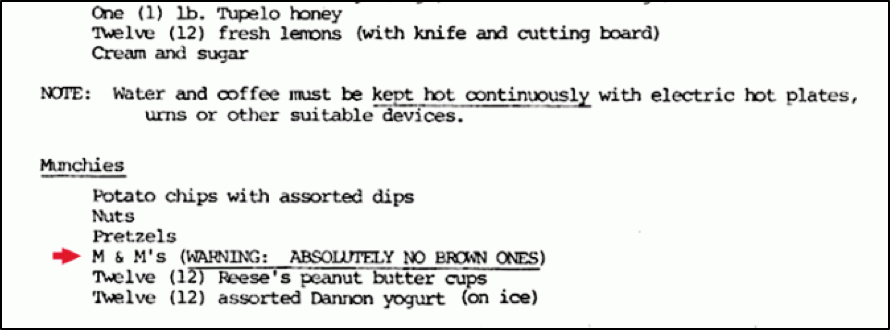My name is Meg Foley. I have worked as the marketing execution co-op at VIA’s Davis Square headquarters since January. And this is the story of how that became the most rewarding experience of my life (so far!).

That’s me!
In my two years at Northeastern University, I have already made major progress towards some of my life goals, like traveling the world, earning a college degree, and getting real-life work experience (and I still have three more years to go!). I studied abroad in Dublin my first semester, went to classes in Boston for the next two semesters, and worked at a startup in Davis Square for the past six months.
These experiences have all made me who I am today and my time at VIA is no exception. I gained essential professional experience, and each lesson stemmed from VIA’s company values.
Respect a good challenge and challenge with respect
We believe in facing challenges head-on with passion and excitement. We’ve created an environment where team members feel psychologically safe to raise alternative ideas and share their personal concerns, helping us reach better outcomes in the end.

The team loves to step out for ice cream on a hot day! And after a particularly warm day in February, J.P. Licks even featured one of our ice cream photos on their social media.
As the marketing execution co-op, one of my primary responsibilities was maintaining our Zoho CRM (a database that helps us manage all our relationships with our ever-expanding network). But more than just maintain this system, I made it my mission to make it even more efficient and effective. One component of that meant making data reports, like our sales pipeline, more visually appealing. To do this, I worked closely with VIA COO, Kate Ravanis, to hash out the goals and strategy for how this would work.
For me, the biggest challenge was putting my Excel knowledge to work and being patient with changing formats and preferences. Through many versions and rounds of feedback with VIA’s executive team, I eventually found a way to incorporate everyone’s input and all the essential details. Now that visual report is a part of the team’s biweekly demo, and this challenging project led to a new staple piece of internal communications!
Learning never goes out of style
Learning is all about feedback and trying new things. Each person, at every position in the company, has frequent feedback sessions with their manager to set goals and priorities, reflect on accomplishments, and discuss areas for improvement and additional support.

Somerville team at our brand launch (this was a huge deal to be a part of)
One of my friends, who is also on a co-op at another organization, was shocked to hear how often I speak with my supervisor on the marketing team. “I wish I could get any feedback at all!” he said. I was proud to have such an open line of communication, which has been so important and useful for my personal growth.
This open communication also meant I was able to speak up about projects I wanted to pursue, like becoming the VIA Culture Coordinator, and skills I wanted to develop, like written communication, so I was really able to shape my role at VIA to better fit me. With each new responsibility I took on, I created a comprehensive process guide so future co-ops can continue building on projects I started, like our new Instagram account. I hope these guides allow for many future smooth transitions from one co-op to another, and that it’s one way I can continue contributing to VIA’s learning-focused environment.
Be each other’s biggest fan
Everyone deserves a high five once in a while! The more we support each other, the more we encourage wide ranging contributions from diverse backgrounds to solve problems.

The marketing team treated me to a fun brunch on my birthday.
Every person on the team is recognized and celebrated for any number of reasons: professional accomplishments, personal victories, or even birthdays.
In fact, on my birthday I was taken to a lovely brunch by my marketing team. This is a fond memory I’ll treasure forever. Celebrating the individual, like we did on my birthday, is central to VIA’s culture. As the Culture Coordinator, I was proud to be a part of creating even more structure around what we celebrate and how, like birthdays (of course), work anniversaries, and fun holidays like Pi Day and Star Wars Day.
Ready, set, RESILIENCE!
We are solving problems that others have considered unsolvable. Difficult problems require patience and grit. Individuals require resilience to approach a major challenge and overcome all the smaller challenges along the way.
During my co-op, VIA achieved a lot of exciting milestones. One that stands out in particular was winning the MITX Best Technology Innovation Concept Award. We were thrilled to learn we were finalists, but in order to qualify for the next round of review, someone from VIA would need to present a demo of our blockchain-based Trusted Analytics Chain (TAC).
Due to the very busy travel schedules of our client and business development teams, the only person available on the night of the demo was a member of our marketing team. She needed to learn (in just one weekend) the inner workings of TAC and how to demo it, and prepare for any number of questions that might come up with the judges (I was happy to help her prepare by asking the most challenging questions I could think of, and many of those were actually asked on the night of!). Without her determination and ability to deal with high stakes situations, traits that come naturally to everyone on the VIA team, this feat couldn’t have been accomplished.
Love in = Love out
We believe that if you love what you do, it will show in the quality and productivity of your work. Twice a year we get together for a company-wide offsite where team members’ contributions are recognized and new ideas are discussed.

The team has grown from then to now, we have 20 employees as of June 2018.
We had an amazing company offsite this April. This experience was one of the times I felt most immersed in VIA’s love in=love out culture. For example, during the offsite we had an ongoing activity: a fun fact scavenger hunt. Everyone received a list of fun facts with blank spaces next to them, and our goal was to match the anonymous fun fact to the right person. You would not believe how much we committed to this scavenger hunt! I had so much fun getting to know everyone on the team through this activity, while enjoying some friendly competition (people even formed alliances to pool their answers!). It just goes to show that when people really love what they do, it shows, even in small moments of downtime during an all company meeting.
Stay curious
Technology today is moving at a super fast pace. Curious people who constantly explore new approaches and think outside the box help find the best possible solutions.

Some of the marketing team at a recruiting event at Northeastern.
AI and blockchain technology are two of the hottest buzzwords in the tech world (and beyond) right now. But, explaining what they mean exactly is not so simple. The marketing team stays curious about how we can better make writing about what we do more accessible, and our CEO Colin Gounden does a great job of sharing creative anecdotes and analogies to help us.
One example of that is his Van Halen story: the band’s 1982 world tour contract explicitly stated there shouldn’t be any brown M&Ms backstage. Colin explains how this seemingly bizarre request actually illustrates how Ethereum’s smart contracting functionality works. People’s eyes light up every time he explains this (a real A-ha! moment). Marketing was even able to use this to write one of our latest blogs: “Rock Science: How Van Halen Invented Smart Contracts”.
Goodbye and thank you!

That’s my team (on St.Patrick’s Day) rocking green.
I will miss VIA. It was an adventure, one I couldn’t have trekked without the team here in Somerville (shout out to Marketing!). It must seem cliché at this point, but there is not a single thing I would change about my co-op. Being at a company that cares about the individual as much as the company is rare, and I think the strong set of values is to thank for that.

